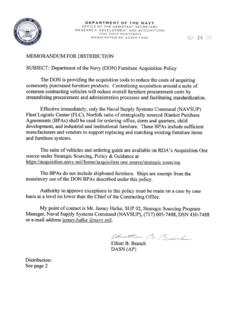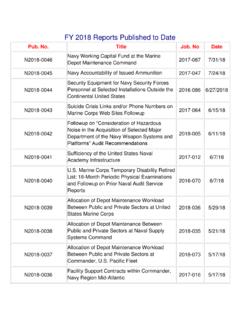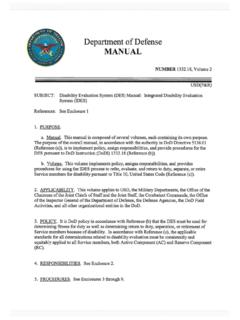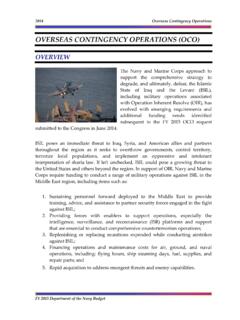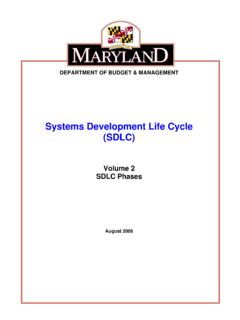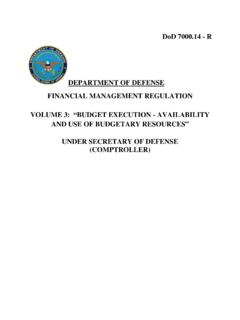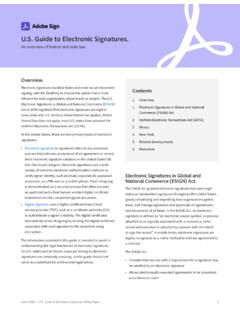Transcription of DEPARTMENT OF THE NAVY OFFICE OF THE C N O N P …
1 DEPARTMENT OF THE NAVY OFFICE OF THE CHIEF OF NAVAL OPERATIONS 2000 NAVY PENTAGON WASHINGTON DC 20350-2000 OPNAVINST N13M 29 Jul 2021 OPNAV INSTRUCTION From: Chief of Naval Operations Subj: NAVAL TRAINING SYSTEMS REQUIREMENTS, ACQUISITION AND MANAGEMENT Ref: (a) OPNAVINST (b) DoD Instruction of 30 December 2019 (c) OPNAVINST (d) SECNAVINST (e) CJCSI (f) OPNAVINST (g) DOD Instruction of 2 February 2017 (h) OPNAVINST (i) SECNAVINST (j) OPNAVINST (k) NAVSO P-1000 of November 2019 (l) SECNAVINST (m) DoD Directive of 8 August 2007 (n) OPNAVINST (o) OPNAVINST (p) COMUSFLTFORCOMINST/COMPACFLTINST (q) OPNAVINST (r) MIL-STD-46855a, Human Engineering Requirements for Military Systems, Equipment and Facilities, 24 May 2011 (s) OPNAVINST (t) DoD Instruction of 7 January 2015 (u) OPNAVINST Encl.
2 (1) Manpower and Training Requirements Planning (2) Training Estimate and Navy Training System Plan Format (3) Training Effectiveness Evaluation Plan (4) Training Installation and Transfer Agreement (5) Rating Continuum (6) Glossary and Acronyms 1. Purpose. To establish policy for planning, determining and documenting Manpower, Personnel and Training (MPT) requirements and development for Navy and Navy and Marine Corps integrated weapons and warfare systems across the entire continuum of Naval training OPNAVINST 29 Jul 2021 2 (Apprentice, Journeyman and Supervisor). The revision aligns with changes in acquisition policy, procedures, responsibility and reporting identified in the Navy Resource Requirements Review Board (R3B) process per reference (a). This instruction is a complete revision and should be reviewed in its entirety.
3 2. Cancellation. OPNAVINST , OPNAVINST 3. Scope and Applicability. This instruction applies to all Navy and Marine Corps programs that deliver Acquisition Category I through IV programs, non-acquisition category programs, modernization and rapid acquisition programs. The instruction is also applicable to abbreviated acquisition programs, non-developmental items, commercial off-the-shelf (COTS), rapid deployment capability, business systems and urgent need programs ( , Government Off-the-Shelf (GOTS) systems). Middle Tier acquisition programs will follow procedures identified in reference (b). Inter-Service Training programs will follow the procedures outlined in reference (c). This instruction facilitates the alignment of the system, manpower and training requirements throughout the lifecycle of the system and Rating Continuums.
4 This instruction also serves as the DEPARTMENT of the Navy (DON) guidance to building a training effectiveness assessment model(s). Compliance with this policy will ensure MPT requirements traceability in support of new or modernized (or both) Navy training capabilities via enclosures (1) through (6). 4. Background. This instruction requires the identification of total force manpower and training requirements and the development of a training sustainment plan for support of Navy and integrated Navy and Marine Corps acquisition or modernization programs. Navy Training System Plans (NTSP) are regulatory documents identified by reference (d) used in planning during the DEPARTMENT of Defense (DoD) acquisition process . References (d) and (e) provide procedural guidance for the Joint Capabilities Integration and Development System (JCIDS) as the primary means for the Joint Requirements Oversight Council (JROC) to fulfill its statutory responsibilities.
5 This instruction includes assessing joint military capabilities and identifying, approving and prioritizing gaps in these capabilities to meet requirements in the National Defense Strategy. Reference (f) addresses the requirements development for human systems integration. 5. Policy. a. A Training Estimate (TE) must be initiated by Milestone (MS) B and completed by MS C for new programs and programs that are initiated at MS B. The completion of the TE is the entrance criteria for the development of an NTSP. The NTSP is submitted for Resource Sponsor (RS) approval, if applicable, during the Production and Deployment (P&D) phase and completed by MS C. RS(s) are required to obtain concurrence from Deputy Chief of Naval Operations (DCNO) for MPT before approving an NTSP. Once approved by the RS, the NTSP is the official record of Navy MPT requirements.
6 Urgent or Joint Emergent Needs programs, non-acquisition programs, modernization and rapid or abbreviated programs, including non-developmental items, COTS, rapid deployment capability recommended for the transition into a OPNAVINST 29 Jul 2021 3 program of record will be incorporated in a TE and follow-on NTSP. business Systems will follow procedures in reference (g). b. A Training Installation and Transfer Agreement (TITA) is required before the Ready for Training (RFT) date. The application of System Command (SYSCOM) procedures for Configuration Data Management Data Managers Database Open Architecture, configuration changes and installation execution is authorized. The document ensures training products, equipment, facilities and infrastructure are in place to support the implementation of the transfer of responsibility for a complete training system from the Training Support Agency (TSA) to the identified Training Agency (TA).
7 Exhibit 1. DON Requirements and Acquisition process with Timeline for Manpower and Training Requirements Documents c. Exhibit 1 details the timeline for acquisition category and non-acquisition category programs with the exception of business support and rapid acquisition programs ( , non-developmental items, COTS, GOTS, rapid deployment capability, abbreviated acquisition program, Speed to Fleet and urgent operational need initiatives). A rapid acquisition program will follow a more constrained milestone schedule aligned to meet warfighter readiness requirements until formal lifecycle sustainment training is in place. Reference (g) describes the business support acquisition cycle with Authority-To-Proceed. OPNAVINST 29 Jul 2021 4 d. The TE is required 5 years before system Initial Operational Capability (IOC) for programs requiring military construction (MILCON), or by the date indicated for programs meeting the criteria in subparagraphs 5d(1) through 5d(3): (1) Four years before system IOC for Acquisition Category I or II programs requiring training device research, development, test and evaluation.
8 (2) Before initial operational test and evaluation or low-rate initial production, whichever comes first. (3) Three months before IOC for rapid acquisition programs such as non-developmental items, COTS, GOTS, rapid deployment capability, abbreviated acquisition program and urgent need initiatives. (a) Reference (d) defines the DON urgent needs and rapid development process that can be fielded in less than 2 years and are below the cost thresholds of Acquisition Category I and IA programs. During the P&D phase, the acquiring organization will provide the identified training and produce a TE to support the operation and sustainment phase requirements. The PM will develop the NTSP to meet operation and sustainment requirements. (b) Integrated weapons, warfare systems and functional areas ( , habitability, damage control, etc.)
9 Require NTSPs. e. Manpower and Training Requirements Planning (MTRP) document, Front End Analysis (FEA), Rating Domain Analysis (RDA) or a Functional Requirements Document (FRD) should include Fleet substantive and critical recommendations for review during a R3B or other governing decision-making processes. Findings will be posted on relevant Web sites or in official repositories. 6. TE and NTSP Development and Approval process . a. Program Managers (PM) are required to implement the MTRP using enclosure (1). The PM will also submit preliminary Program Budget Information System (PBIS) issues to the RS for considerations that support early cost product or logistics support analysis and any unfunded issues within the Program Objective Memorandum (POM) cycle. PMs will produce prescribed products used in the development of a TE, informed by the results of a Type Commander (TYCOM) approved RDA.
10 An NTSP must be informed by a product or logistics support analysis and authoritative data as available. Training solutions development will not start until the TYCOM, TSA and TA concur and the RS approves the MTRP for incorporation into an NTSP. b. TE approval process consists of: OPNAVINST 29 Jul 2021 5 (1) The TE consists of training requirements. The training requirements are derived from the program OFFICE s approved Equipment Systems and Sub-Systems (E/S/S) Logistics Support Analysis and Product Support Analysis, task analysis (maintenance, operations tasks) and TYCOM approved RDA. This milestone B product is developed using MTRP data. The TE will be aligned with the manpower estimate or preliminary manpower documents (or both). The analysis will be updated and transitioned into an NTSP at MS C (See Exhibit 1 in enclosure (2)).


